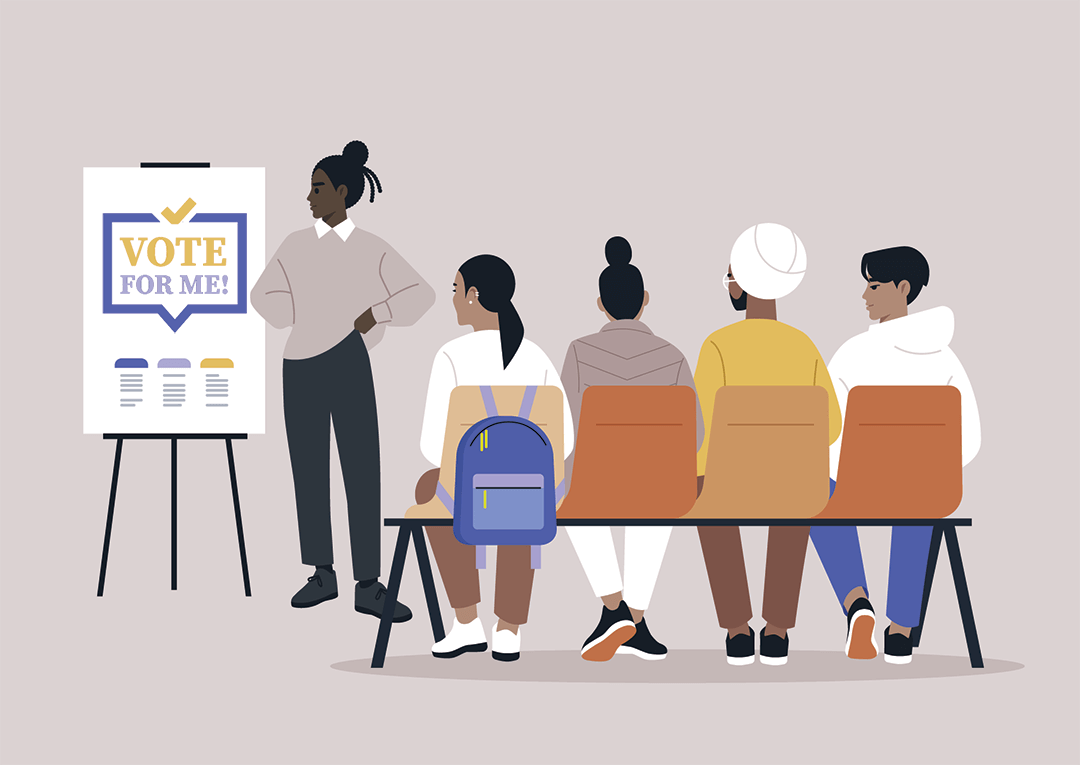For decades, U.S. elections have mutated further from choosing the best public servants for the job to popularity and fundraising contests for cults of personality and special interests. The reasons behind this are varied, systemic and, perhaps at this point, intractable.
But interruptions to these patterns are possible and need to be attempted from every angle available.
Here’s one idea. What if elections and election coverage echoed a format that most people have personally experienced: being hired for a job, or hiring someone for a job?
At its core, the electorate is the hiring committee for the public servants who hold some of the most important offices locally, regionally and nationally. Yet very few of the best practices for hiring are followed in this process.
To play captain obvious, at its most basic, a good hiring process starts with understanding the job to be done, articulating the roles and responsibilities clearly, and determining which qualities, experiences and skills are needed to do it well. It’s also a best practice to name the compensation level, whom they report to and what power they actually have, who reports to them, and how they’ll be judged on performance and be held accountable for not meeting expectations or benchmarks.
Very few newsroom voter guides provide even that essential information. That makes it even harder for the members of the hiring committee, the voting public, to compare candidates and make informed decisions.
A well-rounded and effective hiring process needs to include multiple perspectives and stakeholders — a committee. Newsrooms could tap others who can help round out the job descriptions of each candidate, deliberate and decide on experience needed and other useful (or red flag) attributes. These committees would function much like they would in a healthy organization or company, resulting in a legible description of the job to be done, and a rubric to compare candidates against each other.
Creating these committees is a golden opportunity for transformative community engagement. Newsrooms could form representative groups from demographics that the elected official(s) will be accountable to, and bring them together to create the job description and make recommendations.
Goodbye editorial board endorsements, hello participatory process.
My hunch is that running elections coverage and voter guides like this could result in:
- A new, generative (and focused) frame for how to organize elections coverage and voter guides
- Better, more accessible materials for the electorate to understand and participate in choosing their leaders
- A more thoughtful, intentional process around candidate coverage by newsrooms, including:
- Demoting horse race coverage to focus on the stakes and not the odds
- Engagement journalism rooted in community listening, participation and responsiveness
- Voter guides that highlight candidate overlap with job description, responsibility and experience rather than what politicians are seeking to share as their narrative or sphere of influence
- Creating spaces for collective sense-making and decision-making, thereby supporting community belonging, agency and depolarization
- More accountable candidates who are judged by their experience, qualities and merits rather than their funds, provocative statements or powerful backers.
- And eventually, more people with public service values and experience in positions of power.
Taken together, my theory is that this would translate to a more diverse governing body from a variety of dimensions including: socioeconomic status/class, ethnic/racial background, gender identity, age, and more. And that over time, this pool of public servants would be better equipped to support a functioning, multiracial and pluralistic democracy.
Newsrooms would of course need to decide if that’s a world they feel comfortable helping to usher into existence. At present, horse race and game-frame reporting is actively preventing that world from being possible. So not choosing a different way to report is actually a choice with real-world implications.
I digress.
Right now you might be thinking, OK, let’s say I’m interested in this hiring committee approach. How am I going to get the time to figure out how to run it? I’ve done some (not all!) of that thinking to get you started.
How this could work
The brass tacks of how to implement the hiring committee approach would need to be matched to the participating newsroom’s capacity, interest and communities they serve.
One sticking point I imagine newsrooms would have is in navigating the tension between sharing a “just the facts” run-down of what the candidate’s job entails to generating recommended qualities, experiences and skills of candidates. That latter part is where the community perspective can come in, enabling reporters to not feel as though they are editorializing or unduly propping up their opinions.
Below is a sketch of potential steps in a process that would likely be consistent across any newsroom deploying this model.
Gather job openings
- Newsrooms gather the positions that are up for election
- Either in collaboration with other civic organizations (E.g., libraries, universities, elections boards) or solo, they outline the hard facts of the job description for each position, detailing:
- Title
- Role
- Compensation
- Term
- Areas of Responsibility
- And what is not in their purview. This will help when politicians run on promises or outcomes they are not actually empowered to execute on.
- Whom They report to
- Whom they supervise
- Accountability Structure
Form community hiring committees
- Together with community partners (or alone), newsrooms gather individuals into committees that represent the major dimensions/demographics of the electorate.
- Depending on how many positions are up for election, this may require multiple groups who focus on elements of the ballot (e.g., council members, judges, school boards, mayors, congress, senate, etc.)
- I imagine each committee is composed of between six to 12 community members that contain a spread of experience, age and perspectives.
- In an ideal world, these community members would be remunerated in some way for their participation in this experience that’s commensurate with the time spent supporting the effort. (e.g., a stipend, honorarium)
- The call for committee members could take place through a few methods, including:
- An open call using a newsroom’s (and partner) channels to gather interest
- Tapping community leaders and existing servants to nominate people from their networks
- Lottery system (a la jury duty)
Hiring committee meetings
Depending on the major deadlines of primaries and races, the committees could meet as few as three times. Here’s an example of what each of these meetings could entail.
- Meeting 1: Committee coherence and table setting
- Facilitate a meeting for the committee to get to know each other, why they were interested in the opportunity, learn what’s expected of them and form community norms and guidelines.
- This could happen virtually or in person. If in person, it would require happening in an accessible place (potentially paying for transportation), providing food and child care to ensure equity for participation.
- Meeting 2: Job descriptions deep dive and development
- This meeting would have journalists (and any other partners — such as former elected officials or academics) explain the contours of each job the committee is responsible for weighing in on.
- The committee would generate their ideas for what skills, experience, values and characteristics would best serve this particular role.
- Ideally, the committee would align on the nonnegotiables and “nice to have” elements of the descriptions.
- Meeting 3: Comparing candidates
- Once the committee has consensus on what they are looking for in each leadership position, they’ll meet to review what is known about each candidate.
- To help fill in the blanks, the committee will generate questions or research items for journalists to find answers.
- The committee could also help design (or weigh in on) a candidate questionnaire for the newsrooms to use as part of their voting guide.
- Optional Meeting: Candidate interviews
- Depending on the committee and candidates, they may or may not be able to interview each candidate individually. Ideally, the committees would have access to candidates to get their questions answered directly.
- An alternate option if candidates don’t make themselves available is for journalists to pull the information they can find about candidates for the qualifications the committee deems important, creating a kind of dossier on each candidate that they can also share with the public/their audiences.
- Optional meeting: Issuing recommendations
- Once the committee has all the information they need to understand what issues are at stake, the jobs to be done and candidates running, they’ll generate recommendations from the candidate pool.
- Newsrooms could publish/broadcast/pull from these conversations to show in their voter guides which people the hiring committee are recommending and why.
- Optional Meeting: Voter Guide Review
- If committees do not want to issue recommendations, they could review the voter guide characterizations of each candidate/job to be done and how the newsroom has framed how well each candidate stacks up to the job description.
- See this post “Make your voter guides iconic” as an example of how newsrooms could make it easy to show if a candidate has been endorsed by the committee, or matches the qualifications/qualities.
- If committees do not want to issue recommendations, they could review the voter guide characterizations of each candidate/job to be done and how the newsroom has framed how well each candidate stacks up to the job description.
Journalists as fact-finding support for hiring committees
In between each meeting, journalists would be listening for what additional information the committee needs to understand the roles and make informed recommendations.
They would also transparently report out their process and progress to their audiences and communities through their information distribution channels as they complete or prepare for each step of the hiring committee process. This enables people who aren’t part of the committee to follow along, potentially weigh in, and ultimately trust the process and recommendations more when they are made.
Depending on the comfort level of the hiring committee, they could also be profiled or included in newsroom coverage. If they’re comfortable with being described but not directly named, the newsroom could share an overview with the public for what kinds of people were on the committee so there could be more transparency and hopefully trust that multiple identities were present, heard and weighed in.
Ideally, the meetings would also create some useful content for newsrooms to publish/broadcast about the process as it’s in motion, highlighting a variety of voices and demonstrating how the deliberations are proceeding, potentially ambiently modeling good communication tools.
Could this actually work?
Since I don’t currently run a newsroom, I can’t say for sure. But if you’re up for giving this a try, I’d be happy to figure out ways to support your newsroom in doing so. Fill out this brief form.
And if this isn’t your jam, I’ll be sharing more alternatives to the same old elections coverage approaches over the coming months here on Poynter’s site, some of which newsrooms have already tried and (spoiler alert) are working!
Find more support at Democracy SOS, a collaborative effort of journalism support organizations and non-partisan civic initiatives.







